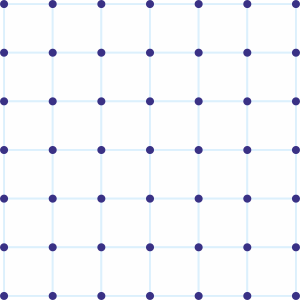Problem
Consider the 6 × 6 square in the figure. Let A₁, A₂, …, A₄₉ be the points of intersections (dots in the picture) in some order.

We say that Aᵢ and Aⱼ are friends if they are adjacent along a row or along a column. Assume that each point Aᵢ has an equal chance of being chosen.
Two distinct points are chosen randomly out of the points A₁, A₂, …, A₄₉. Let p be the probability that they are friends. Then find the value of 7p.
Solution
To find the required probability, we’ll find the number of ways to select any two points, the number of ways to select two friends, and divide the latter by the former.
The total number of ways to select any two points is straightforward. That’s the number of ways of selecting any 2 out of 49 different points, which equals C(49, 2).
Next, selection of two neighbors is equivalent to selecting a horizontal or vertical line segment of unit length. Take a look.

Now, there are 7 horizontal lines in the grid, each composed of 6 of these unit length segments. So, there are 7 x 6 or 42 such segments, i.e. 42 pairs of friends.
Similarly, there are 42 vertical segments, giving us another 42 pairs of friends, giving a total of 84 pairs of friends.
You can explore these segments in the simulation below. Drag the two sliders to see the various segments.
Now, to calculate the required probability p, we’ll divide the favorable number of selections by the total number of ways to select any two points, i.e. C(49, 2).
We’ll get p = 84 / C(49, 2), or 1/14. And therefore, 7p equals 1/2.
Comments
The wording of the problem seemed weird somehow. Too many words to communicate a simple idea, especially when the problem itself wasn’t that complicated. Here’s how I would have worded it:
Here’s a grid of points. Two points are said to be neighbors if they are adjacent either horizontally or vertically, as indicated below.

Two distinct points are chosen randomly from the grid. What is the probability that the points are neighbors?
Much simpler! Not sure why it was made so complicated.
That said, the problem itself was easy enough – the counting involved was direct, and so was the application of the probability formula.